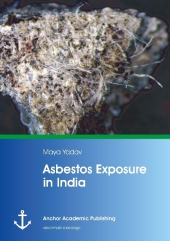 Neuerscheinungen 2016Stand: 2020-02-01 |
Schnellsuche
ISBN/Stichwort/Autor
|
Herderstraße 10
10625 Berlin
Tel.: 030 315 714 16
Fax 030 315 714 14
info@buchspektrum.de |

Maya Yadav
Asbestos Exposure in India
2016. 76 S. 26 Abb. 220 mm
Verlag/Jahr: ANCHOR ACADEMIC PUBLISHING 2016
ISBN: 3-9548945-3-X (395489453X)
Neue ISBN: 978-3-9548945-3-6 (9783954894536)
Preis und Lieferzeit: Bitte klicken
The International Agency for Cancer Research (IARC) classifies asbestos as a proven human carcinogen. No amount of asbestos exposure is safe for human health. Consequently, the use of all forms of asbestos has been banned in most of the developed countries. Unfortunately, India has failed to impose such a ban. Despite the fact that a ban on mining in India is being placed for more than 20 years, mines in the private sector of India are still in operation and asbestos continues to be used in large quantities. The official reason given by both industry and government is that it is a material for the poor as it is cheap and has many good properties. Generally, people in the slum area often cook their food in the open wood fire under asbestos roofing. This results in cracking of asbestos cement roofs exposing asbestos, making it friable as the height of most rural houses roofed with asbestos cement is too small to have effective air circulation. In addition, on the roofs of Indian slums, where it is sawn and fixed by hand, it´s difficult to avoid releasing a large number of dangerous fibers. The inhabitants paint their asbestos roofing with emulsion paint which also deteriorates it, rapidly resulting in discoloration and mould growth. As a result, Asbestos related diseases are more common in the slum area.
In this study, an asbestos cement sample was randomly scanned at various magnifications to identify asbestos fibers and determine how asbestos fibers are mixed with construction materials. Laboratory analyses were performed on the asbestos cement sample to establish a relationship between:
i) morphology (shape of the crystals), ii) the asbestos cement mineralogical composition using SEM analyses and iii) high magnification structure of the individual fibers (fibrils), as well as iv) energy dispersive x-ray analysis of the fiber chemistry by comparison to a standard. Also, quantification analysis of fiber length and thickness was performed due to the reason that fibrogenicity and carcinogenicity of asbestos fibers are both dependent on several fiber parameters including fiber dimensions.
There are several standards specified under the Factories Act and Mines Act including limits of exposure. But standards in India are only on paper. All forms of asbestos pose grave to human health. All are proven human carcinogens. There is no continued justification for the use of asbestos. Ist production and use should be banned worldwide. A global ban on asbestos is needed.
Maya Yadav is from Nepal and recently accomplished her Master degree in Sustainable Resource Management from Technische Universitaet Muenchen, Germany, where her core concentration field was waste management and landscape management. Additionally, she has been working in an NGO named Women in Europe for Common Future (WECF) as Project Assistant for sustainable solutions.


